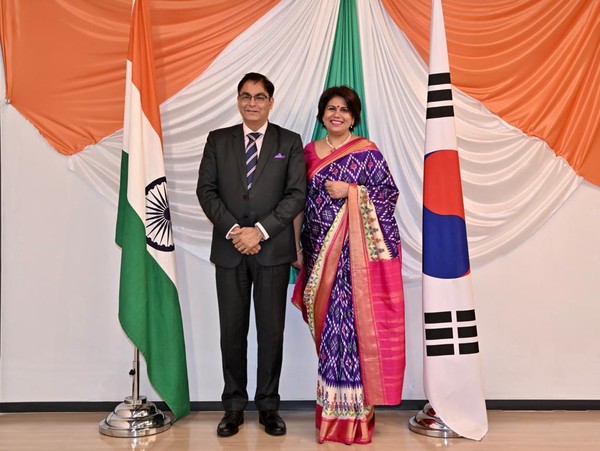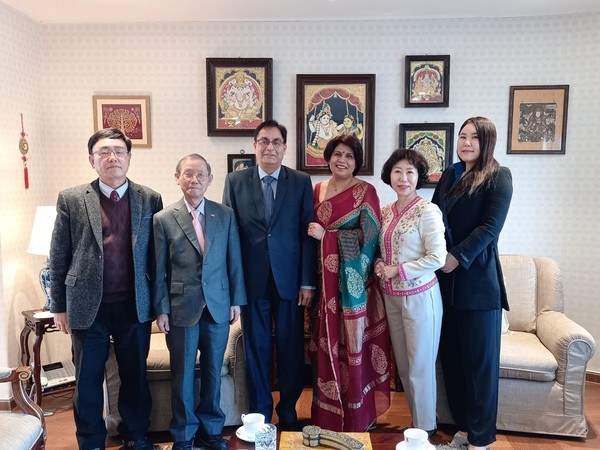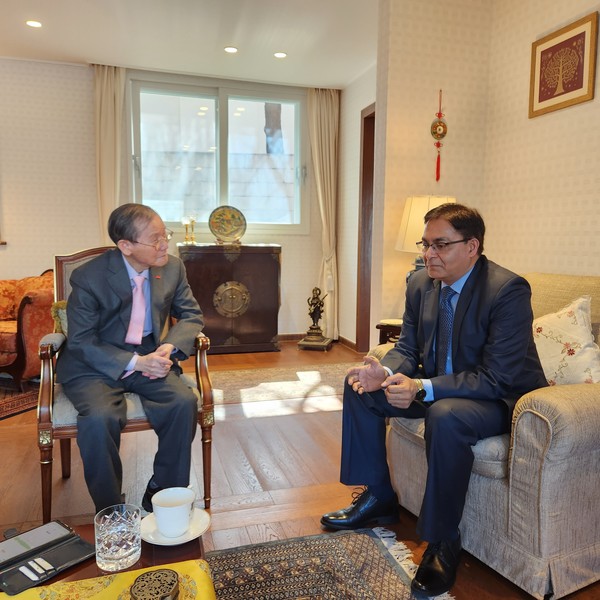Ambassador Kumar of India tells The Korea Post media
By Publisher-Chairman Lee Kyung-sik with VCs Choe Nam-suk, Cho Kyung-hee, Editor Kevin Lee
Ambassador Amit Kumar of India today is the world’s fifth largest economy, registering a growth of 7% in 2022. It is expected to grow at over 6% in the coming two years. Over the next decade, India is projected to become a USD 8.5 trillion economy from the current level of USD 3.4 trillion. India today is changing at an unprecedented rate. One metric, which exemplifies this ongoing transformation is the sheer growth in the number of startups.
In the year 2016, we barely had a few hundred registered start-ups. Today, we have more than 85,000 start-ups, with over a hundred unicorns emerging in the past three years.
Details of the interview with Ambassador Kumar follow:

Question: Our heartiest welcome to Your Excellency as the new Ambassador of India to Korea! Please introduce yourself to our readers to the fullest possible extent, including your family and hobbies. How do you see the role as the new Ambassador of India to Korea. What is the vision for India Korea relationship?
Answer : India and RoK are friendly countries connected by ancient bonds of kinship and Buddhism. In the contemporary era, India’s contribution through its 627 strong medical contingent and the 5500 strong Custodian Forces during the Korean War was one of the significant moments in our relations.

Today, we have much in common. We are both democracies, are free market economies, are entrepreneurial and innovative societies. We are pursuing a Special Strategic Partnership underpinned by a vision of peace, prosperity and people’s connectivity.
I have been in Seoul for close to 10 months. During this time, I have met a large number of Korean friends from different fields, Government, parliament, business, think tanks, media and cultural spheres. I am struck by their goodwill, interest and desire to deepen cooperation with India, a sentiment that we fully reciprocate.

Several important aspects such as trade, commerce and supply chains, security and defence, energy, sustainable development, and climate change, start-ups, new & emerging technologies, all bring us together. The announcement of the RoK Indo-Pacific Strategy and South Korea’s intent to be a Global Pivotal State also offers new opportunities for our two countries to collaborate. We look forward to strengthening cooperation on various regional and global issues.
The year 2023 is a milestone year as we celebrate the 50th anniversary of the establishment of our diplomatic relations. India is also the current G-20 President. We, therefore, have had a very intense calendar of bilateral engagements so far this year including at ministerial and senior official levels. Foreign Minister Park Jin visited India (April) and Finance Minister Nirmala Sitharaman visited RoK (May). President Yoon and PM Modi met in Hiroshima on the sidelines of G7 Summit in May 2023. The two Foreign Ministers again met in Jakarta in July.
We are looking forward to welcome President Yoon to India for the G20 Summit in September. In addition to G20 Ministerial visits, we are also looking at other Ministerial visits during 2023. We have had visits by Governor of Gyeongsangbuk Province and Gyeonggi Province to India in May and July respectively. We have received business delegations from the two main Indian Chambers of Commerce, namely, CII and FICCI apart from numerous other delegations.
I will work with Korean friends to realise new tangible outcomes this year. As Ambassador of India to RoK, it will be my endeavour to widen and deepen our Special Strategic Partnership as well as to promote greater awareness, understanding and friendship among our people.
Q: Please introduce the latest news about India in the economic, political, cultural and other areas—interesting to Korea and the two countries.
A: India today is the world’s fifth largest economy, registering a growth of 7% in 2022. It is expected to grow at over 6% in the coming two years. Over the next decade, India is projected to become a USD 8.5 trillion economy from the current level of USD 3.4 trillion. India today is changing at an unprecedented rate. One metric, which exemplifies this ongoing transformation is the sheer growth in the number of startups.
In the year 2016, we barely had a few hundred registered start-ups. Today, we have more than 85,000 start-ups, with over a hundred unicorns emerging in the past three years.
I would encourage readers to visit India and see first-hand the vast transformation taking place in India. The economic dynamism in India is a direct consequence of consistent structural reforms and regulatory liberalization, relaxation of FDI norms, relentless focus on improving both physical and digital infrastructure and advancing social and financial inclusion undertaken over the past few years. This has set the stage for sustained growth. Our ‘Ease of Doing Business’, innovation and competitiveness rankings have significantly improved. This progress is reflected in the sustained rise of FDIs inflows over the last few years into India, receiving US$ 340 billion of FDI in the last 5 years and US$ 81 billion in the last financial year.
In today’s world, digital infrastructure is perhaps as important as the physical kind and this is where India is leading and taking a unique developmental approach. Unlike other economies where private networks have taken root, India has led the world in building public digital infrastructure.
This year is very important for us as India currently holds the G-20 Presidency. India’s Presidency is being held under the theme – “One Earth, One Family, One Future,” which my Prime Minister Narendra Modi has emphasized will be ambitious, and action oriented. Inclusive growth, including for the global south, SDGs, food and energy security, energy transition, climate finance, and digital transformation will be high on the agenda
Q: What is the present volume of bilateral trade, its outlook in the next 12 months?
A: Our economic and commercial ties are deepening. Our bilateral trade was USD 27.8 billion in 2022. We are working to realize our bilateral trade target of US$ 50 billion well before 2030. Two-way investments are over US$ 12 billion with Korean investments in India at US$ 7 billion.
Major items of India’s export to Korea are light oils and preparations / oil distillates (mainly naphtha), cereals, iron and steel. Digital services, chemicals, pharmaceutical products, marine products, all have large export potential from the Indian perspective. Korea’s main exports to India are automobile parts, telecommunication equipment, refined petroleum products, base lubricating oils, mechanical appliances, electrical machinery & parts and iron & steel products.
The two sides hope to conclude CEPA upgradation negotiations at the earliest. We are seeking more investments from Korean companies in India. There are growing opportunities for cooperation in new and emerging technologies, including in sectors such as IOT, 5G, AI, Start-ups, Green hydrogen, climate change, EVs, etc.
There are over 600 Korean companies including several big companies that have significant presence in India as they have been operating there for a few decades. Nonetheless, the number of Korean companies in India is still relatively low and it would be our effort to attract more Korean companies particularly from the SMEs sector to fully tap into the Indian market.
Q: What are the areas in India where Your Excellency might want Korean companies to invest and what are the areas in Korea where the businessmen your country are desired to invest?
What are India’s competitive products and/or services attractive to Korea? Who are the companies of your country exporting your products services to Korea?
What are the Korean products and services that your country might wish to important?
A: There has been a spotlight on supply chain disruptions particularly in the back drop of the pandemic and geo-political/geo-economical conflicts.
These events have exposed the vulnerability of supply chains, and the risks inherent in single country dependency. Therefore, it is imperative that India and the Republic of Korea work together and grasp emerging opportunities for bilateral cooperation. As Korean companies look for relocating/diversifying their supply chains, India would like to welcome them.
One key national priority for India is to strengthen its manufacturing sector and to integrate it more actively with the global supply chains. In this context, the Government has announced an outlay of US$ 46 billion for the Production Linked Incentive (PLI) Schemes across 14 key sectors including semiconductors, electronics, pharmaceuticals, ACC, food processing, medical devices etc. The PLI scheme has the potential to create six million new jobs and an additional GDP of US$ 400 billion. This has received good response from the global corporate sector and foreign investors as well.
The PLI scheme has been announced in sectors where South Korea has advanced capabilities, such as in life sciences, automobiles, EV batteries, and electronics manufacturing. Through these incentives, India is offering South Korean companies opportunities to expand their production capacities and diversify their supply chains. Several Korean companies have been approved under the PLI scheme, that also include major players such as Samsung Electronics, LG Electronics, Hyundai Motor's, Kia, Mando Automotive India Pvt Ltd. etc.
There are many areas which can be explored by Korean companies in India for their expansion and for collaboration with Indian companies.
A few of them are outlined here: Technology and big data: India has successfully leveraged technology, big data and artificial intelligence to improve governance and delivery outcomes. Both countries have committed to advance and strengthen digital infrastructure. Green economy, renewable energy, electric mobility, hydrogen etc. are areas prioritized by both Governments. India is also taking the lead in the International Solar Alliance and the Coalition for Disaster Relief Infrastructure.
Pandemic and healthcare management: Both countries have a relatively strong pharma industry, especially in the generic segment. There is thus potential for collaboration.
Similarly, manufacturing, construction and infrastructure sectors in India also offer a number of investment opportunities for Korean companies.
India also has a large skilled and semi-skilled workforce that has contributed immensely to several geographies around the world. I believe that they can also mitigate some of the demographic pressures that RoK is facing today. The two Governments are in discussion on this matter.
Q: Who are the major Korean companies actively engaged in bilateral economic cooperation between the two countries? Please introduce them in detail in the order of size and scale of business activities.
A:Several leading Korean companies have invested in India including Hyundai Motor Group, Samsung Electronics, LG Group, etc. In addition to these major companies, there are around 600 Korean companies and entities that have a presence in India, and we expect their numbers to grow in future. Hyundai and Kia are among the top automobile manufacturers in India. Hyundai Motors has set up an automotive plant in Tamil Nadu with a capacity to produce more than 650,000 cars annually, with plans for manufacturing EVs on a big scale in near future. Kia Motors has reached a record milestone by selling over 6.50 lakh units in less than four years of its debut, and has manufacturing units in Andhra Pradesh. Samsung India has two factories (Noida, Tamil Nadu) and five R&D Centres in India, with annual revenues of around US$ 10 billion. LG Electronics operates two factories in India, one each in Noida and Pune, with an R&D Centre in Bangalore.
POSCO owns and operates a steel plant in the western state of Maharashtra, supplying automotive steel to car makers in India. A leading Korean textile firm, Youngone Corporation is setting up eight garments and textiles units in Telangana. POSCO, Hyosung Corporation, CJ Logistics, Lotte confectionery are all looking to expand their presence in India. These are but a few highlights. Several RoK companies are considering investment plans to tap opportunities in India.
Q: Korean people, especially the up-and-coming Korean businessmen need rest and recuperation. What are your tourist attractions?
A: India is a fascinating tourist destination with a multitude of experiences to offer to travelers of all kinds. The country has everything from the globally recognized forty UNESCO World Heritage sites, to exquisite wildlife, beautiful beaches, adventure tourism, and a variety of cuisine and cultural
experiences. The country is dotted with many spiritual destinations which should not be missed by anyone looking for spiritual upliftment or seeking mental solace in this fast-paced world. We have the Buddhist tourist circuit covering several prominent Buddhist heritage sites including those directly related to the life of Lord Buddha. The two countries are well connected by Direct Flights operated by Air India and Korean Air. Flights have resumed and are reaching pre-COVID frequencies. We should, however, work to have more direct flights. Obtaining a tourist visa for India is also very easy and convenient. So, we warmly welcome our Korean friends to visit India and explore its endless and timeless beauty and grandeur.
Q: Who among the Koreans are considered to be most prominently contributing to the promotion of relations, cooperation and friendship between the two countries? We would like to introduce them adequately so that others could follow their suit.
A: The burgeoning bilateral Special Strategic Partnership between India and RoK reflect not only the commitment of our two Governments to consolidate and take forward our relations but also the considerable engagement among a wide-range of important stakeholders drawn from political, think tanks, S&T and academic establishments, business, media and cultural spheres. Overseas Indians and Koreans are also an important bridge, contributing immensely to this effort. This has led our Special Strategic Partnership to become more comprehensive. Yet, I would also underline that there is much potential to further deepen our partnership. As you can imagine, it would be difficult to name key individuals or groups involved in our robust relations. So, I take this opportunity to thank each one of them and look forward to working with them to take India-RoK relations to new heights.
Editor’s note:
According to the Korean Ministry of Foreign Affairs, Korea and India forged diplomatic relations in 1973, paving the way for a sound and steady development in bilateral relations across a wide range of areas, including politics, economy and culture.
The signing of the Korea-India Special Strategic partnership in 2015 and the launching of New Southern Policy by the Republic of Korea in 2017, a policy that is in synchronization with the Prime Minister Narendra Modi government’s Act East Policy, have led to a turnaround in the bilateral ties.
The State Visits of President of Korea to India in July 2018 and of Prime Minister Narendra Modi to Korea in February 2019 have further taken the bilateral ties and friendship between the two countries to a new high.
As a newly emerging power, India holds vast potential and opportunities for bilateral cooperation. Nearly 700 Korean companies, both big and small, have entered the Indian market and increased their investment.
With K-Pop and other Korean Wave contents gaining popularity among the Indian youth, interest of Indian people in Korean culture and language is steadily growing.
In milestone developments, Korean history was included in the Indian school text-books in 2018 and Korean language was offered as a foreign language in Indian secondary schools in 2020.
Around 10,000 Korean nationals live in India and they serve as the backbone of strong bilateral relationship between the two countries.

